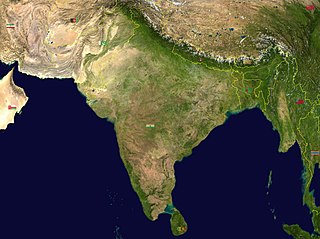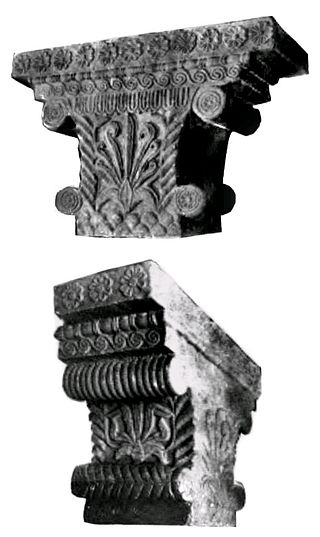In ancient Greek geography, the basin of the Indus River, was on the extreme eastern fringe of the known world.
The Greek geographer Herodotus (5th century BC) describes the land as India, calling it ἡ Ἰνδική χώρη (Roman transliteration: hē Indikē chōrē, meaning "the Indus land"), after Hinduš , the Old Persian name for the satrapy of Punjab in the Achaemenid Empire. Achaemenid king, Darius the Great had conquered this territory in 516 BC.
The Greek colonies in Asia Minor (western and central Turkey) were already part of the Achaemenid Empire since 546 BC and, thus, the Greeks and Indians came into contact with each other as subjects of the Empire. [1]
According to Herodotus 4.44, Scylax of Caryanda, a Greek explorer sailed down the length of the Indus in the service of Darius. Hecataeus of Miletus, around 500 BC, wrote about the geography and peoples of "India", as did the Greek physician Ctesias. Most of these works have not survived in their original form but fragments are known through transmission by later writers. Not only individual Greeks, but also large groups of Greeks were forced to settle in Bactria (northern Afghanistan), who must have had prolonged contact with Indians. Herodotus's account is believed to be based on these accounts. [1]
The Greeks (or Persians) were not aware of the geography of India (or Asia in general) east of the Indus basin. Herodotus in 4.40 uses the term "India" for the Indus basin, and describes it as being on the eastern fringe of the inhabitable world, [2]
But he knew of Indians (Hindwan) living beyond the Persian province of Hinduš (3.101): [3]
In book 3 (3.89-97), Herodotus gives some account of the peoples of India; he describes them as being very diverse, and makes reference to their dietary habits, some eating raw fish, others eating raw meat, and yet others practising vegetarianism. He also mentions their dark skin colour.
In 3.38, Herodotus mentions the Indian tribe of the Callatiae for their practice of funerary cannibalism; in a striking illustration of cultural relativism, he points out that this people is just as dismayed at the notion of the Greeks practising cremation as the Greeks are at that of eating their dead parents. In book 7 (7.65,70,86,187) and in 8.113 Herodotus describes the Indian infantry and cavalry employed in Xerxes' army.[ citation needed ]
As the western travellers went into the rest of the subcontinent through the original "India", the name was gradually extended to the inner regions. By the time of Alexander the Great, at least northern India up to the Ganges delta was known, the regions being referred to as Gangaridai (Ganges country) and Prasii/Prasioi (from Sanskrit prācya, the east), all included in "India". [3] [4] After Megasthenes, a Bactrian Greet that spent several years in the court of Magadha, south India was also known, referred to as Pandaia (Pandya country). [3]
By the 3rd century BC, Eratosthenes recognised "India" as terminating in a peninsula (reflecting a first grasp of the geography of the Indian Subcontinent). Eratosthenes was also the first Greek author to postulate an island Taprobane at the far south of India, later becoming a name of Sri Lanka. European knowledge of the geography of India did not become much better resolved until the end of Antiquity, and remained at this stage throughout the Middle Ages, only becoming more detailed with the beginning of the Age of Sail in the 15th century.

The ancient history of Afghanistan, also referred to as the pre-Islamic period of Afghanistan, dates back to the prehistoric era and the Helmand civilization around 3300–2350 BCE. Archaeological exploration began in Afghanistan in earnest after World War II and proceeded until the late 1970s during the Soviet–Afghan War. Archaeologists and historians suggest that humans were living in Afghanistan at least 50,000 years ago, and that farming communities of the region were among the earliest in the world. Urbanized culture has existed in the land from between 3000 and 2000 BC. Artifacts typical of the Paleolithic, Mesolithic, Neolithic, Bronze, and Iron ages have been found inside Afghanistan.

Bactria, or Bactriana, was an ancient Iranian civilization in Central Asia based in the area south of the Oxus River and north of the mountains of the Hindu Kush, an area within the north of modern Afghanistan. Bactria was strategically located south of Sogdia and the western part of the Pamir Mountains. The extensive mountain ranges acted as protective "walls" on three sides, with the Pamir on the north and the Hindu Kush on south forming a junction with the Karakoram range towards the east.

Atossa was an Achaemenid empress. She was the daughter of Cyrus the Great, the sister of Cambyses II, the wife of Darius the Great, the mother of Xerxes the Great and the grandmother of Artaxerxes I.
Mardonius was a Persian military commander during the Greco-Persian Wars. Though he secured initial victories in the first Persian invasion of Greece, he was ultimately forced to retreat into Anatolia after suffering catastrophic losses in both men and material due to a storm off the coast of Mount Athos, following which he was relieved of his command by Darius the Great. He was later re-appointed by Xerxes I and took part in the second Persian invasion of Greece. In 480 and 479 BC, Mardonius spearheaded the Persian army's destruction of Athens. Shortly thereafter, he was killed during the Battle of Plataea.

Histiaeus, the son of Lysagoras, was a Greek ruler of Miletus in the late 6th century BC. Histiaeus was tyrant of Miletus under Darius I, king of Persia, who had subjugated Miletus and the other Ionian states in Asia Minor, and who generally appointed Greeks as tyrants to rule the Greek cities of Ionia in his territory.

The Republic of India has two principal official short names, each of which is historically significant: India and Bharat. A third name, Hindustan, is also used commonly when Indians speak among themselves. The usage of "Bhārat", "Hindustān", or "India" depends on the context and language of conversation.
Scylax of Caryanda was a Greek explorer and writer of the late 6th and early 5th centuries BCE. His own writings are lost, though occasionally cited or quoted by later Greek and Roman authors. The periplus sometimes called the Periplus of Scylax is not, in fact, by him; that so-called Periplus of Pseudo-Scylax was written in about the early 330s BCE by an unknown author working in the ambit of the post-Platonic Academy and/or the Aristotelian Peripatos (Lyceum) at Athens.
The Massagetae or Massageteans, also known as Sakā tigraxaudā or Orthocorybantians, were an ancient Eastern Iranian Saka people who inhabited the steppes of Central Asia and were part of the wider Scythian cultures. The Massagetae rose to power in the 8th to 7th centuries BCE, when they started a series of events with wide-reaching consequences by expelling the Scythians out of Central Asia and into the Caucasian and Pontic Steppes. The Massagetae are most famous for their queen Tomyris's alleged defeating and killing of Cyrus, the founder of the Persian Achaemenid Empire.

Paropamisadae or Parapamisadae was a satrapy of the Alexandrian Empire in modern Afghanistan and Pakistan, which largely coincided with the Achaemenid province of Parupraesanna. It consisted of the districts of Sattagydia, Gandhara, and Oddiyana. Paruparaesanna is mentioned in the Akkadian language and Elamite language versions of the Behistun Inscription of Darius the Great, whereas in the Old Persian version it is called Gandāra. The entire satrapy,was subsequently ceded by Seleucus I Nicator to Chandragupta Maurya following a treaty.

Hindush was an administrative division of the Achaemenid Empire in modern-day Pakistan. According to the Greek historian Herodotus, it was the "easternmost province" governed by the Achaemenid dynasty. Established through the Persian conquest of the Indus Valley in the 6th century BCE, it is believed to have continued as a province for approximately two centuries, ending when it fell to the Macedonian Empire during the Indian campaign of Alexander the Great.
Maka was a satrapy (province) of the Achaemenid Empire and later a satrapy of the Parthian and Sasanian empires, corresponding to Greek Gedrosia, in the barren coastal areas of modern Pakistan and Iranian Baluchistan. Alternatively, it may have corresponded to modern day Bahrain, Qatar, and United Arab Emirates, plus the northern half of Oman.

Sattagydia was one of the easternmost regions of the Achaemenid Empire, part of its Seventh tax district according to Herodotus, along with Gandārae, Dadicae and Aparytae. It was situated east of the Sulaiman Mountains up to the Indus River in the basin around Bannu in modern day's southern Khyber Pakhtunkhwa, Pakistan.

Carmania is a historical region that approximately corresponds to the current province of Kerman, Iran, and was a province of many Iranic empires such as Medes, Achaemenid, Seleucid, Parthian, and Sasanian Empire. The region bordered Persia proper & the Persian Gulf in the west, Makran & the Makran Sea in the south-east, Parthia in the north, and Aria to the northeast.

In the Greco-Roman world, Ariana was a geographical term referring to a general area of land between Central Asia and the Indus River. Situated far to the east in the Achaemenid Empire, it covered a number of satrapies spanning what is today the entirety of Afghanistan, the easternmost parts of Iran, and the westernmost parts of Pakistan. "Ariana" is Latinized from Greek: Ἀρ(ε)ιανή Ar(e)ianē [region]; Ἀρ(ε)ιανοί Ar(e)ianoi [demonym]. The Greek word, in turn, is derived from the term Airyanem in Avestan.

The Indian campaign of Alexander the Great began in 327 BC and lasted until 325 BC. After conquering the Achaemenid Persian Empire, the Macedonian army undertook an expedition into the northwestern Indian subcontinent. Within two years, Alexander expanded the Macedonian Empire to include Gandhara and the Indus Valley, surpassing the earlier frontiers that had been established by the Persian conquest of the Indus Valley.

The Seleucid–Mauryan War was a confrontation between the Seleucid and Mauryan empires that took place somewhere between 305 and 303 BCE, when Seleucus I Nicator of the Seleucid Empire crossed the Indus river into the former Indian satrapies of the Macedonian Empire, which had been conquered by Emperor Chandragupta Maurya of the Maurya Empire.

The Achaemenid Empire or Achaemenian Empire, also known as the Persian Empire or First Persian Empire, was an Iranian empire founded by Cyrus the Great of the Achaemenid dynasty in 550 BC. Based in modern-day Iran, it was the largest empire by that point in history, spanning a total of 5.5 million square kilometres. The empire spanned from the Balkans and Egypt in the west, most of West Asia, the majority of Central Asia to the northeast, and the Indus Valley to the southeast.

Around 535 BCE, the Persian king Cyrus the Great initiated a protracted campaign to absorb parts of India into his nascent Achaemenid Empire. In this initial incursion, the Persian army annexed a large region to the west of the Indus River, consolidating the early eastern borders of their new realm. With a brief pause after Cyrus' death around 530 BCE, the campaign continued under Darius the Great, who began to re-conquer former provinces and further expand the Achaemenid Empire's political boundaries. Around 518 BCE, the Persian army pushed further into India to initiate a second period of conquest by annexing regions up to the Jhelum River in what is today known as Punjab. At peak, the Persians managed to take control of most of modern-day Pakistan and incorporate it into their territory.

For the ancient Greeks, “India" referred to the geographical region situated east of Persia and south of the Himalayas. During various periods of history, the term expanded to refer to the much wider Indian subcontinent or the much less extensive Indus Plain.

Gandāra, or Gadāra in Achaemenid inscriptions was one of the easternmost provinces of the Achaemenid Empire in South Asia, following the Achaemenid invasion of the Indus Valley. It appears in various Achaemenid inscriptions such as the Behistun Inscription, or the DNa inscription of Darius the Great.